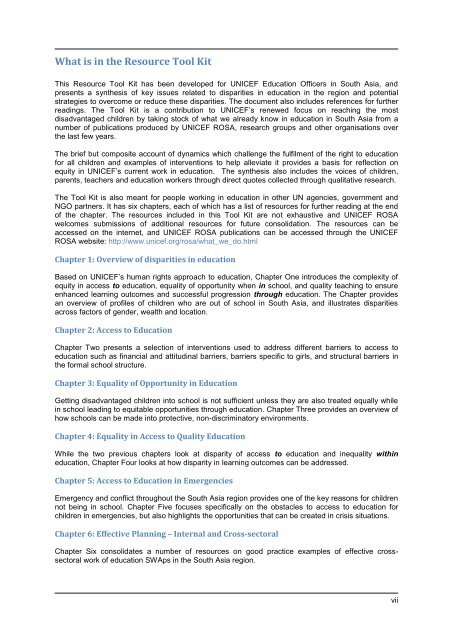DISPARITIES IN EDUCATION IN SOUTH ASIA A Resource Tool Kit
DISPARITIES IN EDUCATION IN SOUTH ASIA A Resource Tool Kit
DISPARITIES IN EDUCATION IN SOUTH ASIA A Resource Tool Kit
Create successful ePaper yourself
Turn your PDF publications into a flip-book with our unique Google optimized e-Paper software.
What is in the <strong>Resource</strong> <strong>Tool</strong> <strong>Kit</strong><br />
This <strong>Resource</strong> <strong>Tool</strong> <strong>Kit</strong> has been developed for UNICEF Education Officers in South Asia, and<br />
presents a synthesis of key issues related to disparities in education in the region and potential<br />
strategies to overcome or reduce these disparities. The document also includes references for further<br />
readings. The <strong>Tool</strong> <strong>Kit</strong> is a contribution to UNICEF’s renewed focus on reaching the most<br />
disadvantaged children by taking stock of what we already know in education in South Asia from a<br />
number of publications produced by UNICEF ROSA, research groups and other organisations over<br />
the last few years.<br />
The brief but composite account of dynamics which challenge the fulfilment of the right to education<br />
for all children and examples of interventions to help alleviate it provides a basis for reflection on<br />
equity in UNICEF’s current work in education. The synthesis also includes the voices of children,<br />
parents, teachers and education workers through direct quotes collected through qualitative research.<br />
The <strong>Tool</strong> <strong>Kit</strong> is also meant for people working in education in other UN agencies, government and<br />
NGO partners. It has six chapters, each of which has a list of resources for further reading at the end<br />
of the chapter. The resources included in this <strong>Tool</strong> <strong>Kit</strong> are not exhaustive and UNICEF ROSA<br />
welcomes submissions of additional resources for future consolidation. The resources can be<br />
accessed on the internet, and UNICEF ROSA publications can be accessed through the UNICEF<br />
ROSA website: http://www.unicef.org/rosa/what_we_do.html<br />
Chapter 1: Overview of disparities in education<br />
Based on UNICEF’s human rights approach to education, Chapter One introduces the complexity of<br />
equity in access to education, equality of opportunity when in school, and quality teaching to ensure<br />
enhanced learning outcomes and successful progression through education. The Chapter provides<br />
an overview of profiles of children who are out of school in South Asia, and illustrates disparities<br />
across factors of gender, wealth and location.<br />
Chapter 2: Access to Education<br />
Chapter Two presents a selection of interventions used to address different barriers to access to<br />
education such as financial and attitudinal barriers, barriers specific to girls, and structural barriers in<br />
the formal school structure.<br />
Chapter 3: Equality of Opportunity in Education<br />
Getting disadvantaged children into school is not sufficient unless they are also treated equally while<br />
in school leading to equitable opportunities through education. Chapter Three provides an overview of<br />
how schools can be made into protective, non-discriminatory environments.<br />
Chapter 4: Equality in Access to Quality Education<br />
While the two previous chapters look at disparity of access to education and inequality within<br />
education, Chapter Four looks at how disparity in learning outcomes can be addressed.<br />
Chapter 5: Access to Education in Emergencies<br />
Emergency and conflict throughout the South Asia region provides one of the key reasons for children<br />
not being in school. Chapter Five focuses specifically on the obstacles to access to education for<br />
children in emergencies, but also highlights the opportunities that can be created in crisis situations.<br />
Chapter 6: Effective Planning – Internal and Cross-sectoral<br />
Chapter Six consolidates a number of resources on good practice examples of effective crosssectoral<br />
work of education SWAps in the South Asia region.<br />
vii
















